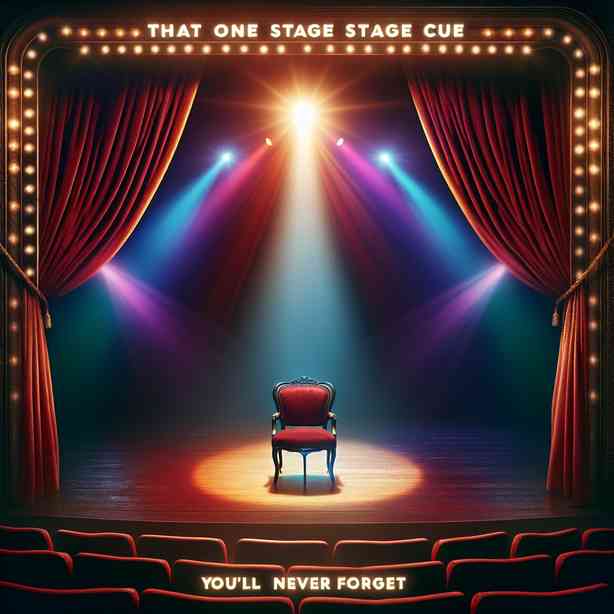
The moment you step onto a stage, a rush of emotions hits you. It’s a blend of excitement, anxiety, and anticipation. For those who have experienced performing arts, you know that there is always that one stage cue you’ll never forget. This cue might seem like a mere signal at first glance, but for many, it becomes a defining moment in their performance journey.
The significance of a stage cue cannot be overstated. It serves as a crucial component that bridges various elements of a performance, from the timing of lights to the entrance of actors and the orchestration of sound. This brief yet powerful signal creates a rhythm, helping to maintain the flow of the entire production. However, the impact of a stage cue goes beyond mere logistical importance; it holds emotional weight, marking turning points in storytelling and character development.
For performers, the anticipation and preparation leading up to that cue can be both thrilling and nerve-wracking. Behind the scenes, actors, dancers, and musicians synchronize their efforts, often battling nerves and excitement. The stage manager, often unseen but always present, plays a vital role in ensuring that everything goes according to plan. Their concentration and precise execution are essential, as they guide performers through each cue. As audience members, we often see only what unfolds on stage, but the unsung heroes working behind the curtains make the magic happen.
One poignant memory that remains etched in the minds of many performers is the very first time they heard their cue. Whether it’s the sound of a gong, the flicker of a light, or even a specific word spoken by another actor, these cues can create moments that resonate long after the final performance. For instance, that moment when the lead actor takes a breath before delivering a powerful line or when dancers seamlessly enter the stage can evoke intense emotions, both for the performers and the audience. It serves as a reminder of the hard work and dedication that went into preparing for that moment.
Each industry has its own way of celebrating these milestones. In theatre, for example, the tradition of a ‘first night’ or opening performance holds immeasurable importance. This occasion not only commemorates the culmination of countless hours of rehearsals but also signifies the moment when the team collectively shares their story for the first time. The anticipation builds leading to the cue when the curtain rises, revealing the set and characters to the audience. On such occasions, every performer takes a mental snapshot of the moment; it’s a ritualistic acknowledgment of the journey they’ve embarked upon together.
Moreover, it is the memories tied to these cues that enrich performers’ lives. Each cue can evoke distinct emotions and reflect personal growth, discipline, and resilience. It is not uncommon for performers to revisit these memories, sharing stories of how they overcame challenges and emerged stronger. Whether it’s overcoming stage fright, mastering choreography, or delivering lines confidently, these experiences shape a performer’s journey in profound ways.
For many, this journey continues long after stepping off the stage. The skills learned through performance—such as teamwork, discipline, and public speaking—often translate into various aspects of life. The ability to remain calm under pressure, to think creatively, and to adapt to unforeseen challenges are invaluable lessons that can be applied in everyday situations. It’s a testament to the transformative power of the arts, instilling resilience and confidence that artists carry with them throughout their lives.
Additionally, the shared experiences created by stage cues forge deep connections among cast and crew members. Each cue often becomes a thread in the fabric of relationships formed during the production. The camaraderie developed in the face of challenges—learning lines, rehearsing tirelessly, and building trust—culminates in those unforgettable moments on stage. It’s a unique bond forged through creativity and collaborative effort, often leading to lifelong friendships.
As we discuss the unforgettable stage cues, it’s essential to consider their impact on the audience as well. Audience members experience a wide range of emotions throughout a performance, often guided by those pivotal moments marked by stage cues. Whether it’s the dramatic pause before a climax or the sudden burst of energy when the music swells, these cues help shape the viewers’ journey. A well-timed cue can ignite laughter, tears, or applause, transforming the audience’s experience into something memorable.
Reflecting on these interactions, it becomes evident that stage cues serve as a language that speaks to both performers and spectators. They facilitate a two-way street of emotional exchange, creating a shared experience that resonates long after the performance concludes. The electricity felt in the theatre, the silence held collectively in moments of suspense, and the eruption of laughter at comedic relief are all part of a delicate dance orchestrated by the cues that guide the flow of the show.
In conclusion, that one stage cue you’ll never forget symbolizes more than just a moment in time; it embodies passion, hard work, and the magic of storytelling. It stands as a testament to the transformative nature of performance art, illustrating how a single cue can shape not only individual journeys but also collective experiences shared with an audience. The rich tapestry woven through the threads of these memories forms an indelible mark on the hearts of all those involved. Whether you are a performer, stage manager, or audience member, the resonance of those cues lingers, reminding us of the profound impact of the arts. So, next time you find yourself in the audience or on stage, remember the true power of that cue—it’s not just a signal; it’s a moment that has the potential to change everything.


